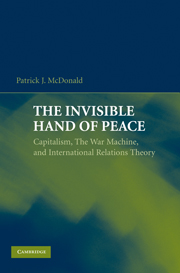Book contents
- Frontmatter
- Contents
- List of Tables
- Acknowledgments
- 1 American Grand Strategy and the Liberal Peace
- 2 Liberal International Relations Theory on War
- 3 Releasing the Invisible Hand
- 4 Liberal Economic Institutions and Peace in the Twentieth Century
- 5 Free Trade and Peace in the First Era of Globalization
- 6 From Rivalry to Friendship
- 7 The Achilles' Heel of Liberal International Relations Theory?
- 8 Peace Across the Taiwan Strait?
- 9 The Invisible Hand or the Ballot Box?
- 10 Capitalism and America's Peaceful Market Power
- References
- Index
8 - Peace Across the Taiwan Strait?
Published online by Cambridge University Press: 05 June 2012
- Frontmatter
- Contents
- List of Tables
- Acknowledgments
- 1 American Grand Strategy and the Liberal Peace
- 2 Liberal International Relations Theory on War
- 3 Releasing the Invisible Hand
- 4 Liberal Economic Institutions and Peace in the Twentieth Century
- 5 Free Trade and Peace in the First Era of Globalization
- 6 From Rivalry to Friendship
- 7 The Achilles' Heel of Liberal International Relations Theory?
- 8 Peace Across the Taiwan Strait?
- 9 The Invisible Hand or the Ballot Box?
- 10 Capitalism and America's Peaceful Market Power
- References
- Index
Summary
Just as World War I has often been held out as the archetypal failure of globalization to prevent war in the nineteenth century, the recent history of confrontation across the Taiwan Strait appears to be a similarly confounding case for claims linking trade and peace. Many contemporary studies of current relations between China and Taiwan begin with an apparent paradox. Just as similar reform initiatives in both China and Taiwan began to unleash a torrent of trade, travel, and investment across the Strait by the end of the 1980s, a brief thawing in cross-Strait relations gave way to the return of substantial political tension between the two by 1995. The visit of Taiwan's president, Lee Teng-hui, to Cornell University in 1995 provoked a military standoff in which the People's Liberation Army test-fired missiles around Taiwan under the guise of multiple military exercises. U.S. President Clinton responded by sending two aircraft carrier groups to the region to deter further military action. Diplomatic crises again broke out after Lee characterized relations between China and Taiwan in 1999 as that between two states and during the campaigns for Taiwanese presidential elections in 2000 and 2004, which were conducted with the threat of independence looming.
Despite a dramatic reorientation in Chinese foreign policy in the era of economic reform whereby Beijing has embraced multilateralism and globalization, settled numerous outstanding territorial disputes, and eschewed support for revolutionary movements around the world, Taiwan appears to have remained relatively exempt from these demonstrations of restraint.
- Type
- Chapter
- Information
- The Invisible Hand of PeaceCapitalism, the War Machine, and International Relations Theory, pp. 233 - 263Publisher: Cambridge University PressPrint publication year: 2009



